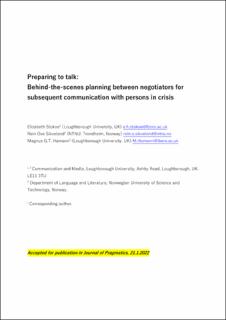| dc.contributor.author | Stokoe, Elizabeth | |
| dc.contributor.author | Sikveland, Rein Ove | |
| dc.contributor.author | Hamann, Magnus | |
| dc.date.accessioned | 2022-10-19T07:49:12Z | |
| dc.date.available | 2022-10-19T07:49:12Z | |
| dc.date.created | 2022-03-14T14:30:16Z | |
| dc.date.issued | 2022 | |
| dc.identifier.citation | Journal of Pragmatics. 2022, 191 113-127. | en_US |
| dc.identifier.issn | 0378-2166 | |
| dc.identifier.uri | https://hdl.handle.net/11250/3026918 | |
| dc.description.abstract | Police negotiators work in small units or teams. In a crisis negotiation, one of the team becomes the ‘primary’ negotiator and talks with the person in crisis. However, because the person in crisis may refuse to participate, and because several negotiators are co-present, there are multiple opportunities for negotiators to talk between themselves, ‘behind-the-scenes’. We used conversation analysis to analyse these interstitial sequences in a corpus of audio-recorded UK suicide crisis negotiations. Our analysis focused on how negotiators talk about what, when, and how to communicate to people in crisis. We found that negotiators evaluated different communication technologies and modalities (e.g., telephone versus face-to-face) and physical locations (e.g., standing on the ground versus on a roof) in terms of their affordances for future interactions and impact on previous ones. Second, negotiators (re)formulated what and how to communicate with persons in crisis and evaluated hypothetical consequences. Third, they evaluated their progress in terms of specific (in)effective words and phrases. The analysis shows how negotiators, in contrast to individual post hoc reflection, come to share live scrutiny of their negotiation practice. Overall, the paper augments what we know about the low frequency but high-stakes activity of crisis negotiation. | en_US |
| dc.language.iso | eng | en_US |
| dc.publisher | Elsevier | en_US |
| dc.rights | Attribution-NonCommercial-NoDerivatives 4.0 Internasjonal | * |
| dc.rights.uri | http://creativecommons.org/licenses/by-nc-nd/4.0/deed.no | * |
| dc.title | Preparing to talk: Behind-the-scenes planning between negotiators for subsequent communication with persons in crisis | en_US |
| dc.type | Peer reviewed | en_US |
| dc.type | Journal article | en_US |
| dc.description.version | acceptedVersion | en_US |
| dc.rights.holder | This is the authors' accepted manuscript to an article published by Elsevier. Locked until 22.2.2024 due to copyright restrictions. | en_US |
| dc.source.pagenumber | 113-127 | en_US |
| dc.source.volume | 191 | en_US |
| dc.source.journal | Journal of Pragmatics | en_US |
| dc.identifier.doi | doi.org/10.1016/j.pragma.2022.01.018 | |
| dc.identifier.cristin | 2009610 | |
| cristin.ispublished | true | |
| cristin.fulltext | postprint | |
| cristin.qualitycode | 2 | |

